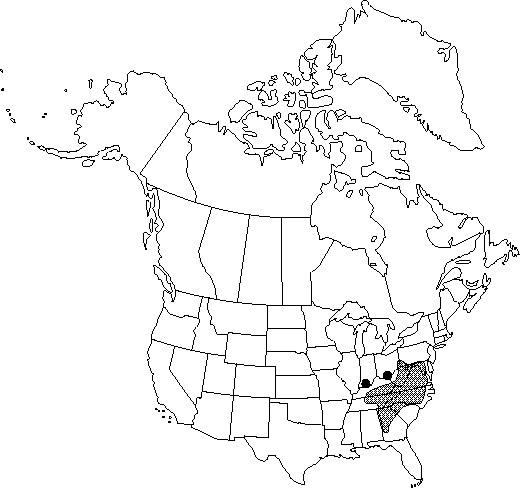Difference between revisions of "Aconitum uncinatum"
Sp. Pl. ed. 2, 1: 750. 1762.
FNA>Volume Importer |
imported>Volume Importer |
||
| (7 intermediate revisions by 2 users not shown) | |||
| Line 13: | Line 13: | ||
}}{{Treatment/ID/Special_status | }}{{Treatment/ID/Special_status | ||
|code=F | |code=F | ||
| − | |label= | + | |label=Illustrated |
}} | }} | ||
|basionyms= | |basionyms= | ||
| Line 19: | Line 19: | ||
|name=Aconitum uncinatum subsp. muticum | |name=Aconitum uncinatum subsp. muticum | ||
|authority=(de Candolle) Hardin | |authority=(de Candolle) Hardin | ||
| − | }}{{Treatment/ID/Synonym | + | |rank=subspecies |
| + | }} {{Treatment/ID/Synonym | ||
|name=Aconitum uncinatum var. acutidens | |name=Aconitum uncinatum var. acutidens | ||
|authority=Fernald | |authority=Fernald | ||
| + | |rank=variety | ||
}} | }} | ||
|hierarchy=Ranunculaceae;Aconitum;Aconitum uncinatum | |hierarchy=Ranunculaceae;Aconitum;Aconitum uncinatum | ||
| Line 30: | Line 32: | ||
}}<!-- | }}<!-- | ||
| − | --><span class="statement" id="st- | + | --><span class="statement" id="st-undefined" data-properties=""><b>Roots </b>tuberous, tubers distally not obviously bulblike, 10-30 × 5-15 mm, parent tuber producing several (ca. 5) daughter tubers separated from parent by connecting rhizomes 5-30 mm. <b>Stems</b> erect, reclining or climbing, 3-25 dm. <b>Cauline</b> leaves: blade 3-5-divided, usually with more than 2 mm leaf tissue between deepest sinus and base of blade, 4-10 cm wide, segment margins cleft and toothed. <b>Inflorescences</b> open racemes or panicles. <b>Flowers</b> commonly blue, 2.5-5 cm from tips of pendent sepals to top of hood; pendent sepals 10-18 mm; hood conic-hemispheric, 15-27 mm from receptacle to top of hood, 13-24 mm wide from receptacle to beak apex.</span><!-- |
-->{{Treatment/Body | -->{{Treatment/Body | ||
| Line 37: | Line 39: | ||
|elevation=200-2000 m | |elevation=200-2000 m | ||
|distribution=Ga.;Ind.;Ky.;Md.;N.C.;Ohio;Pa.;S.C.;Tenn.;Va.;W.Va. | |distribution=Ga.;Ind.;Ky.;Md.;N.C.;Ohio;Pa.;S.C.;Tenn.;Va.;W.Va. | ||
| − | |discussion=<p>Aconitum uncinatum grows in the Appalachian Mountains, on the Piedmont, and on the upper Atlantic Coastal Plain. It is a relatively homogeneous group divided into two intergrading subspecies by J. W. Hardin (1964).</p><!-- | + | |discussion=<p><i>Aconitum uncinatum</i> grows in the Appalachian Mountains, on the Piedmont, and on the upper Atlantic Coastal Plain. It is a relatively homogeneous group divided into two intergrading subspecies by J. W. Hardin (1964).</p><!-- |
--><p>Daughter tubers and connecting rhizomes are seldom present on herbarium specimens because they are easily dislodged during collection.</p><!-- | --><p>Daughter tubers and connecting rhizomes are seldom present on herbarium specimens because they are easily dislodged during collection.</p><!-- | ||
| − | --><p>Available information suggests that Aconitum uncinatum is probably not one of the extremely toxic aconites (D. E. Brink 1982).</p> | + | --><p>Available information suggests that <i>Aconitum uncinatum</i> is probably not one of the extremely toxic aconites (D. E. Brink 1982).</p> |
|tables= | |tables= | ||
|references= | |references= | ||
| Line 48: | Line 50: | ||
-->{{#Taxon: | -->{{#Taxon: | ||
name=Aconitum uncinatum | name=Aconitum uncinatum | ||
| − | |||
|authority=Linnaeus | |authority=Linnaeus | ||
|rank=species | |rank=species | ||
| Line 62: | Line 63: | ||
|publication title=Sp. Pl. ed. | |publication title=Sp. Pl. ed. | ||
|publication year=1762 | |publication year=1762 | ||
| − | |special status=Endemic; | + | |special status=Endemic;Illustrated |
| − | |source xml=https:// | + | |source xml=https://bitbucket.org/aafc-mbb/fna-data-curation/src/2e0870ddd59836b60bcf96646a41e87ea5a5943a/coarse_grained_fna_xml/V3/V3_961.xml |
|genus=Aconitum | |genus=Aconitum | ||
|species=Aconitum uncinatum | |species=Aconitum uncinatum | ||
| − | |||
| − | |||
| − | |||
| − | |||
| − | |||
| − | |||
| − | |||
| − | |||
| − | |||
| − | |||
| − | |||
| − | |||
| − | |||
| − | |||
| − | |||
| − | |||
| − | |||
| − | |||
| − | |||
| − | |||
| − | |||
| − | |||
}}<!-- | }}<!-- | ||
-->[[Category:Treatment]][[Category:Aconitum]] | -->[[Category:Treatment]][[Category:Aconitum]] | ||
Latest revision as of 21:52, 5 November 2020
Roots tuberous, tubers distally not obviously bulblike, 10-30 × 5-15 mm, parent tuber producing several (ca. 5) daughter tubers separated from parent by connecting rhizomes 5-30 mm. Stems erect, reclining or climbing, 3-25 dm. Cauline leaves: blade 3-5-divided, usually with more than 2 mm leaf tissue between deepest sinus and base of blade, 4-10 cm wide, segment margins cleft and toothed. Inflorescences open racemes or panicles. Flowers commonly blue, 2.5-5 cm from tips of pendent sepals to top of hood; pendent sepals 10-18 mm; hood conic-hemispheric, 15-27 mm from receptacle to top of hood, 13-24 mm wide from receptacle to beak apex.
Phenology: Flowering late summer (mid Aug-late Sep).
Habitat: Wet areas along streams and in springs, also less mesic locations in woods and clearings
Elevation: 200-2000 m
Distribution

Ga., Ind., Ky., Md., N.C., Ohio, Pa., S.C., Tenn., Va., W.Va.
Discussion
Aconitum uncinatum grows in the Appalachian Mountains, on the Piedmont, and on the upper Atlantic Coastal Plain. It is a relatively homogeneous group divided into two intergrading subspecies by J. W. Hardin (1964).
Daughter tubers and connecting rhizomes are seldom present on herbarium specimens because they are easily dislodged during collection.
Available information suggests that Aconitum uncinatum is probably not one of the extremely toxic aconites (D. E. Brink 1982).
Selected References
None.
